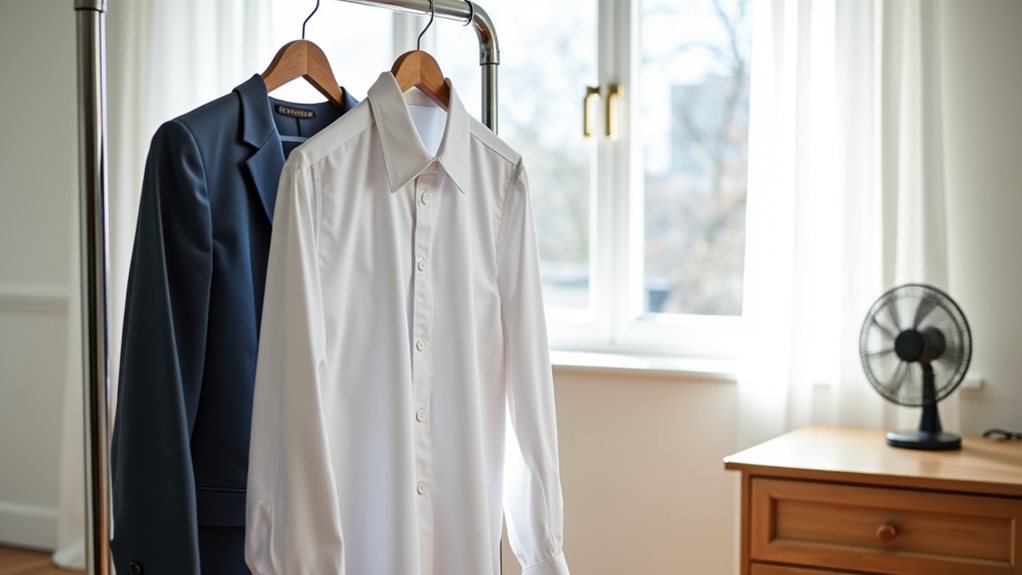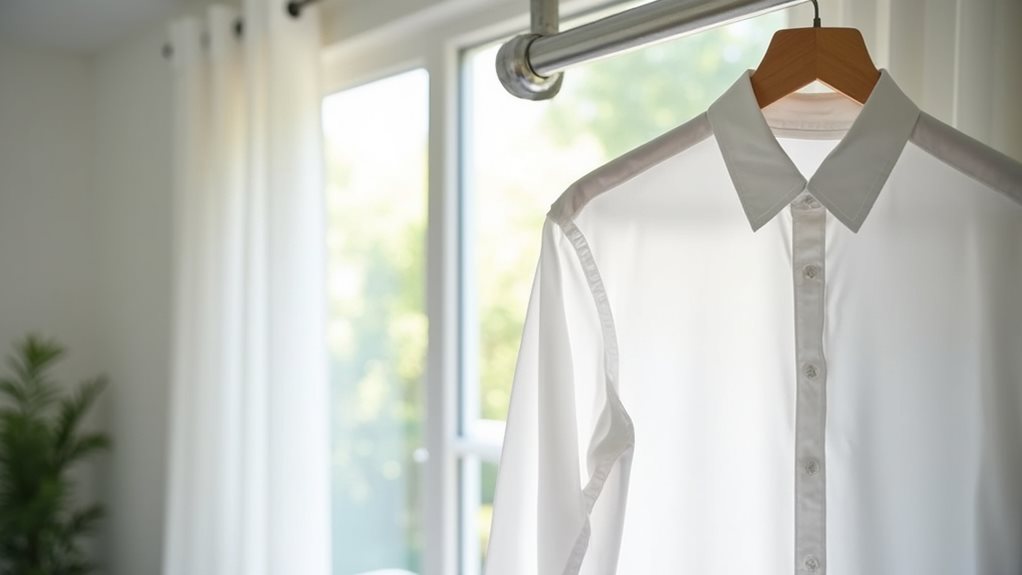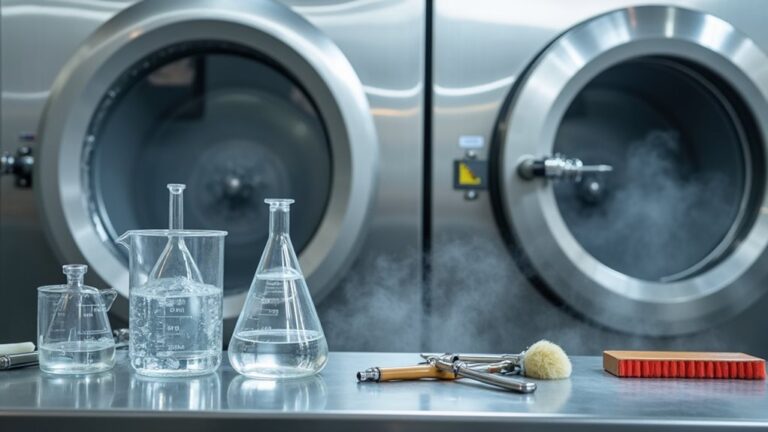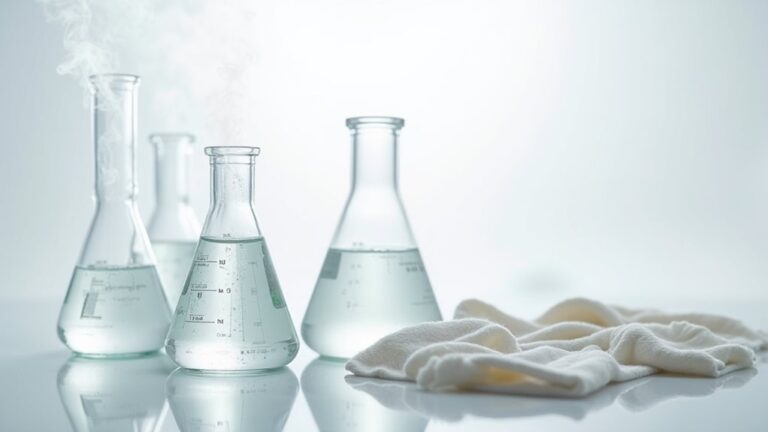You’ll need to air out your dry cleaned clothes for 12-72 hours, depending on the fabric weight and those telltale chemical smells that make you wrinkle your nose. Lightweight fabrics like silk need about 12-24 hours, while heavy items like wool coats require 48-72 hours of ventilation. Those sharp solvent odors aren’t just unpleasant—they’re actually indicating potentially harmful perchloroethylene residues that haven’t fully evaporated yet, and there are smart techniques to speed up this crucial process.
Understanding Chemical Residues in Freshly Dry Cleaned Garments
When you pick up your freshly dry cleaned clothes, that sharp chemical smell isn’t just an inconvenience—it’s actually your garments releasing solvent residues, particularly perchloroethylene (perc), that got absorbed during the cleaning process.
I learned this the hard way when my favorite wool blazer made my entire closet smell like a chemistry lab! 😅
These dry cleaning solvents don’t just magically disappear after the cleaning cycle, especially since many cleaners don’t continuously purify their chemicals, leading to higher contamination levels.
The chemical residues cling stubbornly to fabric fibers, particularly in thicker materials like wool or heavy cotton.
That’s why you’ll need to air out your dry cleaned garments before wearing them—your nose and lungs will thank you later.
While brief exposure to dry cleaned garments is generally low-risk for consumers, allowing proper ventilation helps ensure that the strongest chemical odors dissipate effectively before you wear your clothes.
Factors That Determine Airing Time Requirements

While the general rule might be “air it out for a few hours,” the reality is that several important factors will determine exactly how long you’ll need to hang those garments before they’re ready for your closet.
Your fabric type makes a huge difference—that silk blouse might need just three hours, while your wool coat could require a full day to release those dry cleaning chemicals.
The concentration of solvents used, environmental conditions like humidity and temperature, and any lingering moisture buildup all play essential roles in determining proper care timing.
Higher solvent concentrations, humid conditions, and trapped moisture can significantly extend the airing time your freshly dry-cleaned clothes need.
I’ve learned the hard way that yanking clothes from plastic bags and tossing them straight into confined spaces only traps odors longer, so patience truly pays off here! 😊
This airing process is particularly important because PERC residues can remain on freshly dry cleaned garments and may cause skin irritation or respiratory issues if not properly ventilated.
Recommended Airing Duration for Different Fabric Types

Once you’ve removed those garments from their plastic wrapping, the fabric type becomes your most reliable guide for determining exactly how long to let them breathe before returning to your wardrobe.
Different fabrics absorb and release chemical odors at varying rates, making airing out clean garments a surprisingly nuanced process that I’ve learned through years of trial and error.
Here’s your fabric-specific timeline:
- Lightweight fabrics (silk, polyester) need 12-24 hours of gentle air circulation.
- Medium-weight materials (wool blends, cotton) require 24-48 hours for complete odor elimination.
- Heavy fabrics (denim, outerwear) demand 48-72 hours of patient ventilation.
Items with intricate beading or embellishments need extra time—up to 72 hours—since chemicals love hiding in those decorative crevices like uninvited houseguests.
While traditional dry cleaning uses chemical solvents like perchloroethylene that can pose health risks with prolonged exposure, proper airing reduces any lingering residue to safe levels.
Health Risks of Wearing Clothes With Solvent Odors

Behind that lingering chemical smell lies a more serious concern that I learned about the hard way after experiencing persistent headaches following a week of wearing freshly dry-cleaned work clothes without proper airing.
Those solvent odors you’re detecting aren’t just unpleasant—they’re actually warning signs of potential health risks that shouldn’t be ignored, especially since the EPA has classified perchloroethylene as a possible carcinogen 😬.
When you wear garments with these dry cleaning solvents still present, you’re potentially exposing yourself to dizziness, nausea, and skin irritation through both inhalation and direct contact.
The scary part is that prolonged exposure has been linked to more serious issues like liver damage and reproductive disorders, making proper airing absolutely crucial.
Occupational hazards are particularly severe for dry cleaning workers who face daily exposure to these toxic chemicals in poorly ventilated work environments.
Effective Methods to Speed Up the Airing Process

You don’t have to wait around feeling frustrated while that stubborn dry cleaning smell lingers on your favorite blazer, because there are several smart tricks that’ll cut your waiting time in half.
I learned this the hard way after leaving a wool coat hanging in my closet for days, only to discover that increasing air circulation with a simple fan, using gentle heat sources like sunlight or a warm room, and strategically placing odor absorbers nearby can work together like a well-orchestrated team.
These three methods aren’t just helpful on their own – they’re actually most effective when you combine them, creating the perfect storm for banishing those chemical odors faster than you ever thought possible.
The lingering smell comes from perchloroethylene (PERC), the chemical solvent used in most traditional dry cleaning processes, which can stick to fabric fibers even after cleaning is complete.
Increase Air Circulation
While hanging your freshly dry cleaned clothes in a cramped closet might seem logical, increasing air circulation becomes your secret weapon for banishing those stubborn chemical odors that can linger like an unwelcome houseguest 🏠.
Creating proper airflow transforms your dry cleaned clothes from chemically-scented garments into fresh, wearable pieces again. Here’s how you can accelerate this process:
- Position a fan nearby – Direct airflow helps evaporate lingering solvents faster than passive hanging alone.
- Choose well-ventilated spaces – Garages, spare rooms, or areas near open windows work better than stuffy closets.
- Ditch plastic bags immediately – Switch to breathable fabric garment bags that allow continuous air movement.
I’ve learned that patience pays off here, but strategic placement makes all the difference.
Even experimenting with handheld steamers can help release trapped odors while promoting better circulation around fabric fibers.
The chemical smell you’re trying to eliminate typically comes from perchloroethylene or petroleum-based solvents that haven’t fully evaporated during the cleaning process.
Use Heat Sources
Heat sources become your turbo-boost button when you’re tired of waiting around for those chemical smells to disappear on their own.
I’ve discovered that combining warmth with airflow creates an almost magical transformation in how quickly your garments return to their normal, breathable state. You’ll want to aim for that sweet spot between 70-80°F, which accelerates the evaporation process without turning your favorite blazer into a crispy disaster 😅.
I’ve found that positioning clothes near a heater or sunny window works wonders for airing out stubborn solvent odors, though you’ll need to babysit them like a nervous parent to prevent overheating.
Adding a fan alongside these heat sources creates the perfect storm for faster chemical dissipation.
This approach is particularly effective for garments that weren’t properly aired out during the dry cleaning process, which is one of the common reasons clothes retain chemical odors even after professional cleaning.
Add Odor Absorbers
Although heat works wonders for speeding things up, I’ve learned that strategic odor absorbers can be absolute game-changers when you’re dealing with those persistent chemical smells that seem determined to stick around like unwanted houseguests.
Here’s my tried-and-true arsenal for tackling stubborn dry cleaning odors:
- Baking soda in socks – Fill clean socks with baking soda, tie them off, and place them in sealed garment bags with your clothes for a few days.
- Activated charcoal bags – These powerhouse odor absorbers work alongside your garments, pulling out those pesky chemical residues like tiny smell magnets.
- White vinegar steam – Steam some vinegar near your clothes to neutralize perchloroethylene smells faster.
While dry cleaning is highly effective at removing most odors from garments using powerful solvents, sometimes those same chemicals can leave behind their own temporary scents that require airing out.
Combining these odor absorbers with proper ventilation creates an unstoppable team that’ll have your clothes smelling fresh in record time.
Signs Your Garments Need Additional Ventilation Time

How can you tell when your freshly dry-cleaned clothes haven’t quite finished their chemical detox process? Your nose becomes your best detective 🕵️♀️, because that sharp, almost medicinal scent clinging to your garments means they need more ventilation time to release those stubborn residual chemicals.
That sharp, medicinal scent lingering on your dry-cleaned clothes is a clear signal they need more time to air out completely.
I’ve learned the hard way that thicker fabrics like wool sweaters hold onto odors much longer than my lightweight silk blouses, sometimes requiring an extra day or two of patient airing.
If you notice any dampness or condensation when removing clothes from their plastic bags, that’s another red flag requiring immediate attention.
Most telling, though, are physical symptoms like headaches or dizziness after wearing freshly dry cleaned clothes – your body’s way of saying “not yet, friend.”
Sometimes the unpleasant smell might actually be body odor that wasn’t completely removed during cleaning, especially if contaminated solvents were used or if your garments weren’t properly separated from heavily soiled items.
Choosing Dry Cleaners That Minimize Chemical Exposure

Since discovering that my favorite blazer once made me feel lightheaded for an entire workday, I’ve become quite the detective when it comes to choosing dry cleaners who prioritize my health over convenience.
You shouldn’t have to sacrifice your well-being for clean clothes, and honestly, finding the right cleaner feels like discovering a hidden gem 💎.
Here’s what I look for when vetting potential dry cleaners:
- Solvent practices – I ask about continuously purified and filtered solvents that reduce chemical residue.
- Non-toxic dry cleaning alternatives – Look for cleaners using liquefied sand or pure liquid silicone.
- Wet cleaning methods – Some cleaning uses water-based processes that avoid harsh chemicals entirely.
Choose dry cleaners who’ll transparently discuss their methods, because your health deserves that level of honesty and care.
Many cleaners are now adopting safer alternatives like liquid carbon dioxide and biodegradable solvents to reduce the health risks associated with traditional chemical processes.




